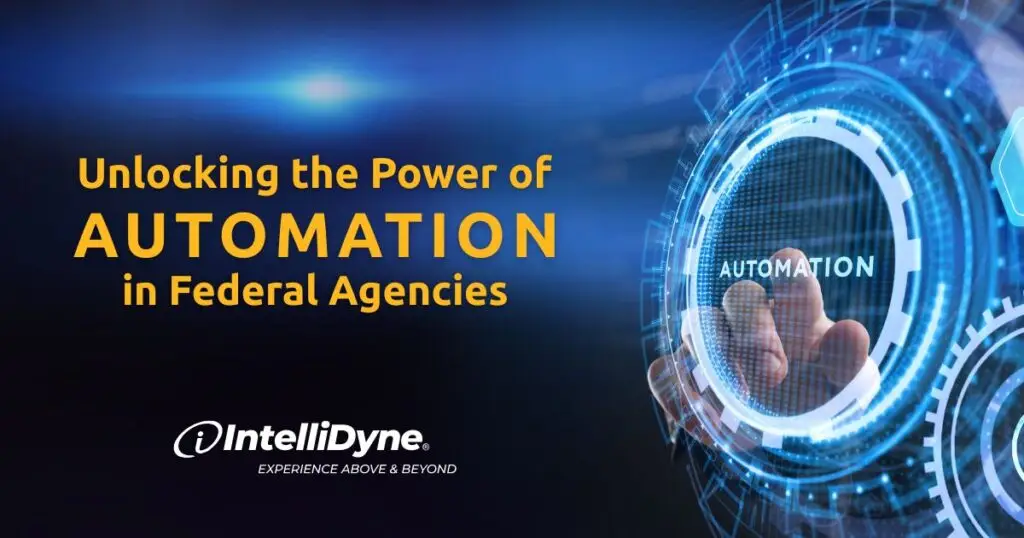Originally published by Government Technology Insider, the article below explores how federal agencies can leverage automation to improve speed, efficiency, and cost savings. With more than 80 percent of IT leaders seeking automation solutions to tackle workforce shortages, cybersecurity threats, and customer experience challenges, it’s critical to choose the right tool for the job.
Featuring expert insights from IntelliDyne’s Vice President of Technology and Innovation, Ali Malik, and Data Scientist AI/ML Practice Lead, Austin Keller, the article provides a detailed overview of four key automation technologies — including Robotic Process Automation (RPA), IT Process Automation (ITPA), Automated Data Pipelines, and Augmented Analytics — that are driving innovation across the public sector. Read on to discover how automation can help agencies meet mission objectives more efficiently and effectively.
Original Article (from “Government Technology Insider“, April 16, 2024):
According to a report published by Resolve, more than 80 percent of IT leaders want to use automation solutions to improve speed, efficiency, and cost savings. Automation tools empower federal agencies with the ability to overcome a number of challenges, such as skilled workforce shortages, cybersecurity concerns, and customer experience optimization. However, because there are so many different types of automation solutions, it can be easy for an agency to misdiagnose what tool will best address the challenge(s) they’re facing. Selecting the wrong automation tool can create unnecessary complexities early on in the process.
In an interview with Government Technology Insider, Ali Malik, IntelliDyne’s Vice President of Technology and Innovation, discussed why it’s important to have expert guidance when selecting the automation solution that best meets the agency’s unique needs. “Providing agencies with this insider knowledge and education is vital for the success of an automation strategy,” Malik said. “In a fully mature automation enterprise, you’ll find evidence of successful implementations of each type of automation. There’s not one magic hammer to solve every problem across an entire enterprise. There are many different types of automation, and you have to have the appropriate tool sets for each.”
The following is a brief overview of four automation tools that can help to improve speed, efficiency, and cost savings within federal agencies.
Robotic Process Automation (RPA)
Robotic Process Automation (RPA) can be used to automate predictable and repetitive tasks using defined data and structured inputs and outputs. Implementing RPA solutions can result in saving employees hours of manual labor and generate significant savings for government agencies. These time savings allow employees to focus on helping constituents with more complicated requests, which can improve customer experiences.
In a report published by the Federal RPA Community of Practice, Gerard Badorrek, Chief Financial Officer at General Services Administration (GSA), wrote about the need to accelerate the adoption of RPA and other automation tools within government. “All agencies are charged with pursuing workload elimination, and RPA provides a low-cost tool to make an immediate impact,” Badorrek wrote. “If the government deployed RPA at scale and achieved only 20 hours of workload elimination per employee, the net capacity gained would be worth $3 billion – and that is only scratching the surface.”
IT Process Automation (ITPA)
IT Process Automation (ITPA) builds on the capabilities of RPA and applies them at an operational level to automate both simple and complex processes. ITPA solutions can be leveraged with advanced technologies to respond automatically to event-driven workflows and processes, schedule jobs, manage assets, and more. Over time, ITPA tools can take a complex process and find ways to improve efficiency and cost savings.
Automated Data Pipelines
Automated Data Pipelines are developed to extract, transform, and load (ETL) data efficiently and consistently to help ensure the data is delivered to the right place at the right time. This automation tool can help to improve the accuracy, timeliness, and quality of the data which can allow agencies to gain insights from data to make informed decisions and respond to organizational changes with speed and accuracy.
One federal agency under the Military Health System (MHS) used Automated Data Pipelines to update its cybersecurity dashboards. This saved the in-house network services team an average of four to six hours a day in performing daily security tasks.
Augmented Analytics
Augmented Analytics combines the abilities of Artificial Intelligence (AI), Business Intelligence (BI), Machine Learning (ML), and RPA technologies in a user-friendly platform. With Augmented Analytics, users don’t need to have an in-depth background in data science to be able to conduct sophisticated data analysis and gain insights from data to accelerate the decision-making process.
In a recent interview with Government Technology Insider, Austin Keller, IntelliDyne’s Data Scientist AI/ML Practice Lead, spoke on the benefits of using augmented automation to drive innovation in the public sector. “[Augmented Automation], it’s a great way to peel the onion, where you can start with small things that enable the user to stop performing those repetitive tasks, and actually empower them to do meaningful work.”
Automation will play a critical role in the evolution of government. Automation solutions can enable faster and more accurate results while addressing challenges like workforce shortages. By enabling the right automation solutions, federal agencies will be able to better meet mission goals while improving speed, efficiency, and cost savings.
Learn more about automation tools that can move government forward here.

